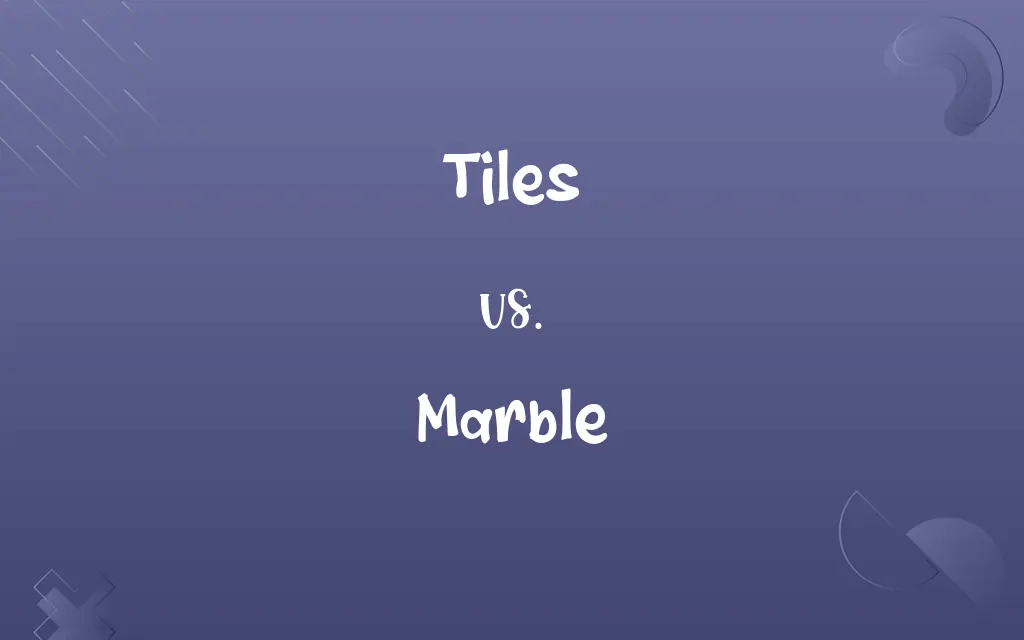Tiles vs. Marble: Know the Difference

By Hifza Nasir & Shumaila Saeed || Published on April 7, 2024
Tiles offer versatile design options and are cost-effective, while marble is a natural stone known for its luxury and unique veining patterns.

Key Differences
Tiles, made from materials like ceramic, porcelain, or stone, provide a wide range of designs, colors, and textures, suitable for various applications from floors to walls. Marble, a type of metamorphic rock, is prized for its distinctive veining and lustrous finish, offering a touch of elegance and luxury to any space.
Shumaila Saeed
Apr 07, 2024
While tiles are celebrated for their durability and ease of maintenance, especially in high-traffic areas, marble is valued for its natural beauty and uniqueness. Each marble piece is one-of-a-kind, reflecting a history millions of years in the making. However, marble requires more maintenance and is more prone to staining and scratching compared to most tiles.
Hifza Nasir
Apr 07, 2024
Cost-wise, tiles offer a more budget-friendly option, with a wide range of prices depending on the type and quality. Marble, on the other hand, is generally more expensive, both in terms of the material itself and the installation costs, due to its weight and the skill required to install it properly.
Hifza Nasir
Apr 07, 2024
In terms of installation, tiles are relatively easier and less costly to install. They can be cut to fit various spaces and are more forgiving during the installation process. Marble installation requires more precision and expertise, often leading to higher labor costs.
Shumaila Saeed
Apr 07, 2024
Environmental impact and sustainability are also considerations; tiles can be produced with recycled materials and consume less energy in production, whereas marble quarrying has a significant environmental impact. However, marble's longevity can offset some of these concerns over time.
Hifza Nasir
Apr 07, 2024
ADVERTISEMENT
Comparison Chart
Design Options
Wide range of colors, designs, textures
Unique veining, natural patterns
Hifza Nasir
Apr 07, 2024
Durability
High, suitable for high-traffic areas
Prone to staining/scratching, but long-lasting
Hifza Nasir
Apr 07, 2024
Cost
Budget-friendly, varies by type
Generally expensive, higher installation cost
Hifza Nasir
Apr 07, 2024
ADVERTISEMENT
Environmental Impact
Lower, can use recycled materials
Higher due to quarrying, but durable
Shumaila Saeed
Apr 07, 2024
Tiles and Marble Definitions
Tiles
Available in a wide range of colors and patterns for design flexibility.
They chose vibrant tiles to create a unique kitchen backsplash.
Hifza Nasir
Mar 05, 2024
Marble
A luxurious natural stone known for its unique veining and polished finish.
The marble countertops added an elegant touch to the kitchen.
Shumaila Saeed
Mar 05, 2024
Tiles
A durable, versatile flooring or wall covering made from materials like ceramic or porcelain.
The bathroom was renovated with waterproof ceramic tiles.
Shumaila Saeed
Mar 05, 2024
ADVERTISEMENT
Marble
Prized in architecture and art for its aesthetic appeal.
The ancient sculpture was carved from a single block of marble.
Hifza Nasir
Mar 05, 2024
Tiles
Suitable for high-traffic areas due to their resistance to wear.
Porcelain tiles were selected for the busy office lobby.
Dua Fatima
Mar 05, 2024
Marble
While expensive, it's valued for its durability and timeless beauty.
The investment in marble flooring was seen as a value addition to the property.
Dua Fatima
Mar 05, 2024
Tiles
Can be made from recycled materials, offering a sustainable option.
The eco-friendly home used tiles made from recycled glass.
Shumaila Saeed
Mar 05, 2024
Marble
Each piece is one-of-a-kind, reflecting natural beauty.
The foyer featured a striking marble floor with distinct veining.
Hifza Nasir
Mar 05, 2024
Tiles
Easy to maintain and clean, ideal for busy households.
The spill was easily cleaned up from the glazed tiles.
Hifza Nasir
Mar 05, 2024
Marble
Requires regular maintenance to prevent staining and etching.
They sealed the marble vanity annually to protect its surface.
Hifza Nasir
Mar 05, 2024
Tiles
A thin, flat or convex slab of hard material such as baked clay or plastic, laid in rows to cover walls, floors, and roofs.
Hifza Nasir
Mar 05, 2024
Marble
A metamorphic rock formed by alteration of limestone or dolomite, often irregularly colored by impurities, and used especially in architecture and sculpture.
Hifza Nasir
Mar 05, 2024
Marble
Something resembling or suggesting metamorphic rock, as in being very hard, smooth, or cold
A heart of marble.
A brow of marble.
Hifza Nasir
Mar 05, 2024
Marble
A thing made of, or resembling, marble, as a work of art, or record, in marble; or, in the plural, a collection of such works; as, the Arundel or Arundelian marbles; the Elgin marbles.
Hifza Nasir
Mar 05, 2024
Repeatedly Asked Queries
Can tiles replicate the look of marble?
Yes, porcelain and ceramic tiles can be designed to mimic the look of marble, offering a cost-effective alternative with easier maintenance.
Hifza Nasir
Apr 07, 2024
Why is marble considered luxurious?
Marble's unique veining, lustrous finish, and association with historical architecture and art contribute to its luxurious reputation.
Hifza Nasir
Apr 07, 2024
What are the main differences between tiles and marble?
Tiles offer a wide range of design options and are more cost-effective, while marble is a natural stone known for its luxury and unique patterns.
Shumaila Saeed
Apr 07, 2024
Which is more expensive, tiles or marble?
Marble is generally more expensive than tiles, both in terms of material cost and installation.
Hifza Nasir
Apr 07, 2024
Are tiles or marble more durable?
Tiles, particularly porcelain, are generally more durable and resistant to staining and scratching compared to marble.
Hifza Nasir
Apr 07, 2024
Can tiles be used outdoors?
Yes, certain types of tiles, like porcelain, are suitable for outdoor use due to their low water absorption rate and durability.
Hifza Nasir
Apr 07, 2024
How often does marble need to be sealed?
Marble typically needs to be sealed once a year to protect it from staining and etching.
Shumaila Saeed
Apr 07, 2024
Is there an eco-friendly option between tiles and marble?
Tiles, especially those made from recycled materials, are considered more eco-friendly due to lower energy consumption in production and the option for recycling.
Dua Fatima
Apr 07, 2024
Why do some prefer marble despite its higher maintenance?
Many prefer marble for its unparalleled natural beauty, unique patterns, and the luxurious feel it adds to spaces.
Shumaila Saeed
Apr 07, 2024
What is the installation process like for tiles vs. marble?
Tiles are easier and less costly to install, while marble requires more expertise and precision, leading to higher labor costs.
Hifza Nasir
Apr 07, 2024
Are there health benefits to choosing marble or tiles?
Tiles, particularly those with antimicrobial properties, can be beneficial for health by reducing the presence of bacteria and molds.
Hifza Nasir
Apr 07, 2024
Can marble be used in high-traffic areas?
While marble can be used in high-traffic areas, it requires more maintenance to maintain its appearance over time.
Hifza Nasir
Apr 07, 2024
How do tiles and marble affect property value?
Both can increase property value, but marble is often seen as a premium upgrade due to its luxurious appeal.
Hifza Nasir
Apr 07, 2024
Can marble tiles be a compromise between solid marble and ceramic tiles?
Yes, marble tiles offer the beauty of natural marble with potentially easier installation and cost benefits compared to solid marble slabs.
Shumaila Saeed
Apr 07, 2024
How do environmental impacts compare between quarrying for marble and manufacturing tiles?
Quarrying for marble has a significant environmental impact, including landscape disruption and energy use, while tile manufacturing can be more sustainable, especially when using recycled materials.
Shumaila Saeed
Apr 07, 2024
Share this page
Link for your blog / website
HTML
Link to share via messenger
About Author
Written by
Hifza NasirCo-written by
Shumaila SaeedShumaila Saeed, an expert content creator with 6 years of experience, specializes in distilling complex topics into easily digestible comparisons, shining a light on the nuances that both inform and educate readers with clarity and accuracy.









































































